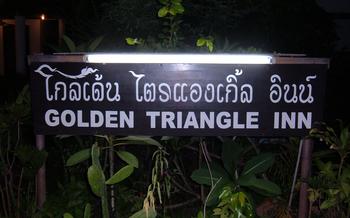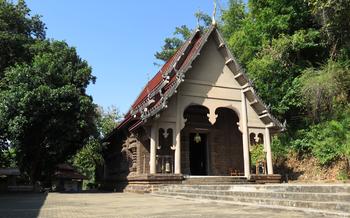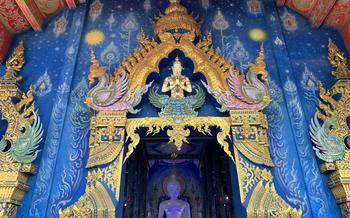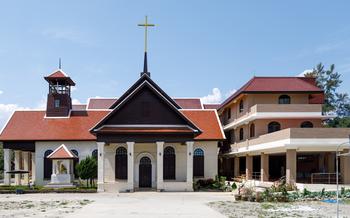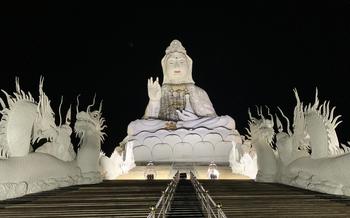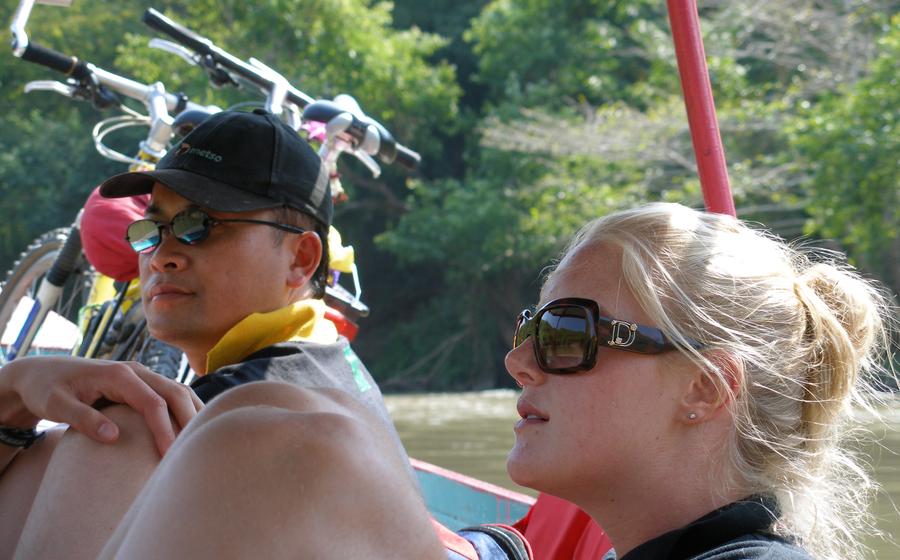
Mekong River Cruise
- A Journey to Chiang Rai: Unveiling the Enchanting Landscapes of Northern Thailand
- The Mighty Mekong River: A Lifeline Through Southeast Asia
- Cruising the Mekong: A Unique Perspective on Chiang Rai's Beauty
- Destinations Along the Mekong: Unveiling Hidden Gems
- The Golden Triangle: A Thrilling Encounter with History and Nature
- Chiang Saen: A Historical City with Ancient Ruins and Serene Temples
- Pak Beng: A Tranquil Village Nestled Amidst Pristine Scenery
- Luang Prabang: A UNESCO World Heritage Site with Timeless Charm
- A Journey Through Time
- Temples and Spiritual Delights
- Cultural Celebrations and Vibrant Festivals
- Natural Wonders and Scenic Delights
- Elephant Sanctuaries: An Ethical Encounter with Gentle Giants
- Hill Tribe Villages: A Glimpse into Diverse Ethnic Cultures
- Trekking Adventures: Exploring the Untamed Jungles of Chiang Rai
- Highlights of Trekking in Chiang Rai
- Tips for Trekking in Chiang Rai
- White Temple (Wat Rong Khun): A Masterpiece of Contemporary Art
- Black House (Baan Dam): A Quirky Museum of Strange and Wonderful Objects
- Insider Tip: Hidden Gems and Local Experiences
A Journey to Chiang Rai: Unveiling the Enchanting Landscapes of Northern Thailand
Chiang Rai, a captivating province nestled in the northernmost corner of Thailand, beckons travelers with its rich history, breathtaking landscapes, and vibrant culture. Founded in 1262 by King Mangrai, Chiang Rai served as the capital of the Lanna Kingdom, a powerful empire that ruled over much of northern Thailand and Laos. Today, the city retains a distinct charm, blending ancient traditions with modern influences. Chiang Rai's strategic location on the banks of the mighty Mekong River, amidst rolling hills and lush rainforests, makes it a haven for nature enthusiasts, adventurers, and history buffs alike. The province boasts a pleasant climate year-round, with warm and sunny days and cool nights inviting visitors to explore its many wonders. The local culture is deeply rooted in Lanna traditions, with a strong emphasis on Buddhism, art, and craftsmanship. Chiang Rai is also home to a diverse population, including hill tribes and ethnic minorities, each contributing to the province's rich cultural tapestry. The best time to visit Chiang Rai is during the cool and dry season, from November to March, when the weather is ideal for outdoor activities.
The Mighty Mekong River: A Lifeline Through Southeast Asia
Flowing through the heart of Southeast Asia, the Mekong River holds immense significance for Thailand and its neighboring countries. This mighty river serves as a vital lifeline, providing sustenance, transportation, and cultural connections throughout the region.
Historical and Cultural Importance:
The Mekong River has shaped the history and culture of Thailand for centuries. Ancient civilizations flourished along its banks, and it played a crucial role in trade and commerce. The river's diverse ecosystems supported thriving fisheries and agriculture, becoming a source of livelihood for millions of people.
Contribution to the Local Economy:
The Mekong River continues to play a vital role in Thailand's economy. It supports various industries, including agriculture, fishing, and tourism. The river's fertile floodplains provide rich soil for rice cultivation, a staple crop for Thailand and the region. Additionally, the river serves as a major transportation route, facilitating trade and commerce between Thailand and its neighbors.
Environmental and Ecological Value:
The Mekong River is home to an incredibly rich and diverse ecosystem. Its waters support a wide variety of fish species, as well as other aquatic life. The river's banks are lined with lush forests, providing habitat for numerous plant and animal species. The Mekong also plays a crucial role in the region's water cycle, ensuring a steady supply of water for agriculture and human consumption.
Cruising the Mekong: A Unique Perspective on Chiang Rai's Beauty
A Mekong River cruise offers a unique and unforgettable perspective on the stunning landscapes and rich cultural heritage of Chiang Rai. Whether you choose a leisurely day trip or an extended multi-day journey, cruising the Mekong provides a tranquil escape from the hustle and bustle of city life.
There are several types of cruises available to suit different preferences and budgets. From intimate small-group cruises to larger, more luxurious vessels, there's something for everyone. Day cruises typically last around 4-6 hours and include stops at key destinations along the river, allowing you to explore temples, villages, and other attractions. Multi-day cruises, ranging from 2 to 7 days, offer a more immersive experience, with overnight stays on the boat and the chance to explore more remote destinations.
Prices for Mekong River cruises vary depending on the type of cruise, the duration, and the amenities included. Day cruises typically start at around $50 per person, while multi-day cruises can range from $200 to $1,000 per person. It's advisable to book your cruise in advance, especially during the peak tourist season, to secure your preferred dates and avoid disappointment.
When planning your Mekong River cruise, consider the time of year you're traveling. The best time to visit Chiang Rai is during the dry season, from November to April, when the weather is pleasant, and the skies are clear. During the rainy season, from May to October, the river levels can rise, making it more challenging to navigate.
Recommended itineraries for a Mekong River cruise in Chiang Rai include stops at the Golden Triangle, Chiang Saen, Pak Beng, and Huay Xai. These destinations offer a diverse range of experiences, from historical temples and ancient ruins to bustling markets and stunning natural scenery. With its tranquil waters, lush jungle landscapes, and fascinating cultural encounters, a Mekong River cruise is a must-do experience for any traveler seeking an authentic and unforgettable journey through Chiang Rai.
Destinations Along the Mekong: Unveiling Hidden Gems
As your Mekong River cruise glides along the shimmering waters, you'll encounter a series of captivating destinations that showcase the region's rich cultural heritage and natural wonders.
One of the highlights is the ancient city of Chiang Saen, renowned for its well-preserved ruins and serene temples. Explore the remnants of old city walls, marvel at the intricate carvings adorning ancient stupas, and soak in the spiritual ambiance that permeates the air.
Further downstream, the tranquil village of Pak Beng awaits with its pristine scenery and laid-back atmosphere. Take a leisurely stroll along the riverbanks, soak in the picturesque views, and savor the flavors of authentic Lao cuisine at the local markets. The village also offers opportunities for hiking and exploring the surrounding countryside.
As the cruise continues, you'll reach Huay Xai, a vibrant town that comes alive at night with its bustling night market. Immerse yourself in the lively atmosphere as you browse a myriad of stalls selling local street food, handicrafts, and souvenirs. Don't miss the chance to indulge in the town's culinary delights, including the famous grilled fish and sticky rice.
The journey culminates in Luang Prabang, a UNESCO World Heritage Site that exudes timeless charm. Admire the well-preserved colonial architecture and ancient temples that line the streets, each telling a story of the city's rich history. Experience the vibrant cultural scene, witness traditional festivals, and marvel at natural wonders like the stunning Kuang Si Falls.
The Golden Triangle: A Thrilling Encounter with History and Nature
Nestled in the heart of Chiang Rai, the Golden Triangle is an enigmatic region where three countries - Thailand, Laos, and Myanmar - converge. Once notorious as a major hub for the opium trade, this area has undergone a transformation, emerging as a captivating destination that blends history, nature, and cultural diversity.
The Golden Triangle's allure lies in its unique geographical location, where the Mekong and Ruak rivers meet, creating a natural border between the three nations. Visitors can embark on a thrilling boat ride along the mighty Mekong, marveling at the stunning scenery and catching glimpses of traditional villages perched along the riverbanks.
Beyond its historical significance, the Golden Triangle is an ecological paradise, boasting diverse ecosystems and an abundance of natural wonders. The region is home to lush forests, rolling hills, and cascading waterfalls, providing a sanctuary for a variety of flora and fauna. Visitors can explore the region's national parks, such as the Doi Pha Tang National Park, and encounter exotic wildlife, including elephants, tigers, and a myriad of bird species.
The Golden Triangle is a place where history intertwines with nature, creating a captivating tapestry of experiences. It offers visitors the chance to delve into the region's rich past while immersing themselves in its breathtaking landscapes. Whether it's exploring ancient opium trails, visiting hill tribe villages, or simply soaking in the natural beauty, the Golden Triangle promises an unforgettable journey for every traveler.
Chiang Saen: A Historical City with Ancient Ruins and Serene Temples
Chiang Saen, a small town located on the banks of the Mekong River, boasts a rich historical legacy. Once a prosperous trading hub, it was the capital of the Lanna Kingdom in the 14th century. Today, visitors can explore its ancient ruins and serene temples, which offer a glimpse into the region's rich past.
The city's most prominent attraction is Wat Phra That Chom Kitti, a revered temple perched atop a hill overlooking the Mekong River. Believed to have been built in the 13th century, it features a stunning golden chedi that dominates the skyline. The temple grounds offer breathtaking views of the surrounding countryside, making it a popular spot for sunset watching.
Another must-see site in Chiang Saen is Wat Pa Sak, a forest temple renowned for its tranquil ambiance and impressive collection of Buddha images. Situated on a hillside amidst lush greenery, the temple exudes a serene atmosphere that invites contemplation and spiritual reflection. Visitors can wander through the temple grounds, admire the intricate carvings on the Buddha images, and soak in the peaceful surroundings.
For history enthusiasts, Chiang Saen National Museum is a treasure trove of artifacts and exhibits that showcase the town's rich cultural heritage. The museum houses a collection of ancient pottery, sculptures, and religious objects, providing insights into the region's past and its significance as a trading center.
Chiang Saen's charm extends beyond its historical sites. The town itself is a delightful blend of old and new, with narrow streets lined with traditional wooden houses and modern cafes and boutiques. Visitors can stroll along the riverside promenade, soak in the local atmosphere, and savor delicious Thai cuisine at one of the many restaurants offering panoramic views of the Mekong River.
Pak Beng: A Tranquil Village Nestled Amidst Pristine Scenery
As your Mekong River cruise gently glides into the tranquil village of Pak Beng, you'll be greeted by a serene ambiance and breathtaking natural beauty. Nestled amidst lush greenery and towering limestone karsts, Pak Beng offers a sanctuary of peace and tranquility, far removed from the hustle and bustle of city life.
The village is a haven for nature enthusiasts, with stunning views of the Mekong River that stretch as far as the eye can see. Take your time to explore the serene surroundings, soak in the tranquility, and let the natural beauty wash away all your worries.
Pak Beng is also home to a bustling local market, where you can immerse yourself in the vibrant culture and culinary delights of the region. Sample the delicious local cuisine, browse the colorful stalls for unique handicrafts, and interact with the friendly villagers who are always eager to share their stories and traditions.
For those seeking a deeper connection with nature, Pak Beng offers ample opportunities for hiking and nature exploration. Embark on a guided trek through the surrounding jungles, where you'll encounter diverse flora and fauna, including exotic birds, rare orchids, and cascading waterfalls. Discover hidden caves, explore pristine forests, and revel in the unspoiled beauty of the natural world.
Whether you're seeking tranquility, adventure, or a taste of authentic local culture, Pak Beng is a must-visit destination along your Mekong River cruise in Chiang Rai. Let the charm of this enchanting village captivate your senses and create lasting memories that will stay with you long after your journey ends.
Luang Prabang: A UNESCO World Heritage Site with Timeless Charm
Nestled along the banks of the Mekong River, Luang Prabang exudes a timeless charm that has earned it a well-deserved spot as a UNESCO World Heritage Site. Steeped in history and tradition, this enchanting city boasts a treasure trove of well-preserved colonial architecture, ancient temples, and vibrant cultural heritage.
A Journey Through Time
Luang Prabang's rich history is palpable in its every corner. The city served as the royal capital of the Kingdom of Lan Xang from the 14th to the 16th century, leaving behind a legacy of magnificent temples and palaces. The influence of French colonization is also evident in the city's elegant boulevards and colonial-era buildings, creating a unique blend of architectural styles.
Temples and Spiritual Delights
Luang Prabang is home to a multitude of sacred temples that offer a glimpse into the city's deep-rooted spiritual traditions. Among the most revered is Wat Xieng Thong, a 16th-century temple adorned with intricate carvings and shimmering stupas. Wat Mai Suwannaphumaham, with its striking golden façade, is another must-visit, offering panoramic views of the city and the surrounding countryside.
Cultural Celebrations and Vibrant Festivals
Luang Prabang comes alive during its many cultural festivals and celebrations. The annual Boun Pi Mai, or Water Festival, is a joyous occasion where locals and visitors alike engage in water-splashing revelry, symbolizing the cleansing of sins and the start of a new year. The colorful Boun That Luang Festival, held every November, showcases traditional parades, merit-making ceremonies, and vibrant performances that honor the city's patron deity, Phra Bang.
Natural Wonders and Scenic Delights
Beyond its cultural and historical treasures, Luang Prabang is blessed with stunning natural landscapes. Just a short boat ride away, the Kuang Si Falls cascade down a series of limestone terraces, creating a breathtaking spectacle. The surrounding pools offer refreshing swimming spots amidst the lush jungle scenery.
Whether you're exploring its ancient temples, immersing yourself in its vibrant culture, or marveling at its natural beauty, Luang Prabang promises an unforgettable experience that will transport you back in time and leave you with lasting memories.
Elephant Sanctuaries: An Ethical Encounter with Gentle Giants
In Chiang Rai, ethical elephant tourism is highly valued, and several reputable elephant sanctuaries offer visitors an opportunity to interact with these gentle giants in a responsible and compassionate manner. These sanctuaries prioritize the well-being of elephants, ensuring they are treated with respect and live in a natural, stress-free environment. Visitors can observe elephants in their natural habitat, feed them, and even bathe them in the river.
One of the most popular elephant sanctuaries in Chiang Rai is the Elephant Nature Park. This sanctuary is home to over 50 rescued elephants, many of which have been victims of abuse or neglect. Visitors to the park can learn about the elephants' individual stories, witness their rehabilitation process, and contribute to their ongoing care.
Another highly regarded elephant sanctuary is the Boon Lott's Elephant Sanctuary. This sanctuary is located in a beautiful jungle setting and offers a variety of programs, including elephant trekking, bathing, and feeding. Visitors can also learn about the history and culture of elephants in Thailand, and the importance of protecting these magnificent creatures.
When visiting an elephant sanctuary in Chiang Rai, it is essential to choose one that is reputable and adheres to strict ethical standards. Look for sanctuaries that do not offer elephant rides, as this can be harmful to the elephants' backs. Instead, opt for sanctuaries that focus on observation, interaction, and education, ensuring that your visit contributes positively to the well-being of these majestic animals.
Hill Tribe Villages: A Glimpse into Diverse Ethnic Cultures
Chiang Rai is home to a diverse array of hill tribes, each with its own unique traditions, customs, and lifestyles. These tribes have lived in the region for centuries, and their cultures are an integral part of the local heritage. Visitors to Chiang Rai have the opportunity to visit these villages and interact with the locals, gaining a deeper understanding of their way of life.
The Akha, Karen, Hmong, Lahu, and Lisu are among the most prominent hill tribes in Chiang Rai. Each tribe has its own distinct language, dress, and customs. Visitors can learn about their traditional way of life, including their farming practices, religious beliefs, and social structures.
Many of the hill tribe villages are located in remote areas, and getting to them can be an adventure in itself. However, the rewards are well worth the effort. Visitors will be greeted with warm hospitality and have the opportunity to experience a way of life that is rapidly disappearing.
When visiting hill tribe villages, it is important to be respectful of their customs and traditions. Visitors should dress modestly and avoid taking photos without permission. It is also important to remember that these villages are not museums, and the people who live there are not exhibits. Visitors should treat them with the same respect they would show anyone else.
By visiting hill tribe villages, travelers can gain a deeper understanding of the diverse cultures that make up Chiang Rai. These villages offer a unique glimpse into a way of life that is slowly disappearing, and they are a must-see for any visitor to the region.
Trekking Adventures: Exploring the Untamed Jungles of Chiang Rai
Chiang Rai's diverse landscapes offer thrilling trekking adventures for nature enthusiasts. The untamed jungles, lush rainforests, and mountainous terrains provide an unforgettable experience for those seeking adventure and connection with nature. Guided tours are available for trekkers of all levels, ensuring safety and providing valuable insights into the region's ecosystem and wildlife.
Highlights of Trekking in Chiang Rai
-
Diverse Jungle Terrains: From dense rainforests to bamboo groves and rolling hills, Chiang Rai's jungles offer a variety of terrains to explore.
-
Stunning Landscapes: Trekkers can marvel at cascading waterfalls, panoramic mountain views, and lush greenery that stretches as far as the eye can see.
-
Wildlife Encounters: The jungles are home to a diverse array of wildlife, including elephants, tigers, gibbons, and exotic birds.
-
Natural Wonders: Discover hidden caves, sparkling streams, and towering ancient trees that add to the mystique of the jungle experience.
Tips for Trekking in Chiang Rai
-
Choose a Reputable Tour Operator: Ensure that your tour operator is reputable, experienced, and committed to safety.
-
Be Prepared for the Elements: Pack appropriate clothing, sturdy footwear, and rain gear, as weather conditions can change quickly in the jungle.
-
Respect the Environment: Leave no trace behind, and avoid disturbing the natural habitat of wildlife.
-
Listen to Your Guide: Your guide is there to ensure your safety and provide valuable information about the jungle's ecosystem and wildlife.
White Temple (Wat Rong Khun): A Masterpiece of Contemporary Art
Nestled in the heart of Chiang Rai, the White Temple, or Wat Rong Khun, stands as a testament to the boundless creativity and artistic vision of Thai artist Chalermchai Kositpipat. Unlike any other temple in Thailand, the White Temple captivates visitors with its unique architectural design and intricate symbolism, blurring the lines between sacred and contemporary art.
The temple's gleaming white exterior, adorned with shimmering mirrors, reflects the sunlight, creating an ethereal and otherworldly aura. Every surface is covered in intricate carvings and sculptures, each telling a story from Buddhist mythology or Thai folklore. The central ubosot, or ordination hall, is the focal point of the temple, its walls and ceiling adorned with vibrant murals depicting scenes of heaven, hell, and the cycle of rebirth.
The White Temple is a testament to the power of art to transcend religious and cultural boundaries. It has become a symbol of Chiang Rai, attracting visitors from around the world who come to marvel at its beauty and immerse themselves in its unique spiritual atmosphere.
Black House (Baan Dam): A Quirky Museum of Strange and Wonderful Objects
Nestled amidst lush tropical gardens, the Black House (Baan Dam) stands as a testament to the eccentric genius of Thai artist Thawan Duchanee. This unique museum, adorned in dark wood and adorned with intricate carvings, invites visitors to explore a world of strange and wonderful objects.
From the moment you step through the gates, you'll be immersed in a surreal environment. The Black House is a collection of 40 interconnected buildings, each filled with an eclectic array of artifacts, sculptures, and curiosities. From animal bones and skulls to antique furniture and religious icons, every corner of the museum holds a surprise.
Duchanee, a renowned architect and artist, created the Black House as a reflection of his personal philosophy and artistic vision. The museum's unconventional design and unique collection challenge traditional notions of art and beauty. Visitors are encouraged to question the boundaries between the ordinary and the extraordinary, the beautiful and the grotesque.
As you wander through the Black House, you'll encounter a menagerie of strange and fascinating objects. There are animal horns and teeth arranged in intricate patterns, antique furniture adorned with human skulls, and bizarre sculptures that seem to defy explanation. The museum's collection is a testament to Duchanee's boundless imagination and his ability to transform the ordinary into the extraordinary.
Beyond the main house, the surrounding gardens are equally captivating. Sculptures of mythical creatures, towering trees, and tranquil ponds create a surreal landscape that invites exploration and contemplation. The Black House is not just a museum; it's an immersive experience that challenges your perceptions and leaves you with a lasting impression.
Insider Tip: Hidden Gems and Local Experiences
Beyond the popular tourist attractions, Chiang Rai offers a wealth of hidden gems and authentic local experiences. Venture off the beaten path to discover tranquil temples nestled amidst lush greenery, vibrant local markets brimming with fresh produce and handmade crafts, and charming villages where time seems to stand still.
Indulge in the culinary delights of Northern Thai cuisine, renowned for its bold flavors and unique ingredients. Sample mouthwatering dishes like khao soi, a flavorful curry noodle soup, or sai ua, a spicy grilled sausage. Don't miss the chance to visit a night market, a lively affair where you can savor delicious street food, shop for souvenirs, and soak up the lively atmosphere.
Immerse yourself in the rich cultural heritage of Chiang Rai by attending one of the many festivals and events that take place throughout the year. Witness the colorful processions, traditional dances, and vibrant performances that showcase the unique customs and traditions of the region.
To truly experience the essence of Chiang Rai, connect with the warm and welcoming locals. Engage in conversations, learn about their way of life, and embrace the opportunity to gain a deeper understanding of Thai culture. Whether it's sharing a meal, visiting a local market, or simply exchanging smiles, these interactions will create lasting memories and provide a glimpse into the heart and soul of Chiang Rai.
